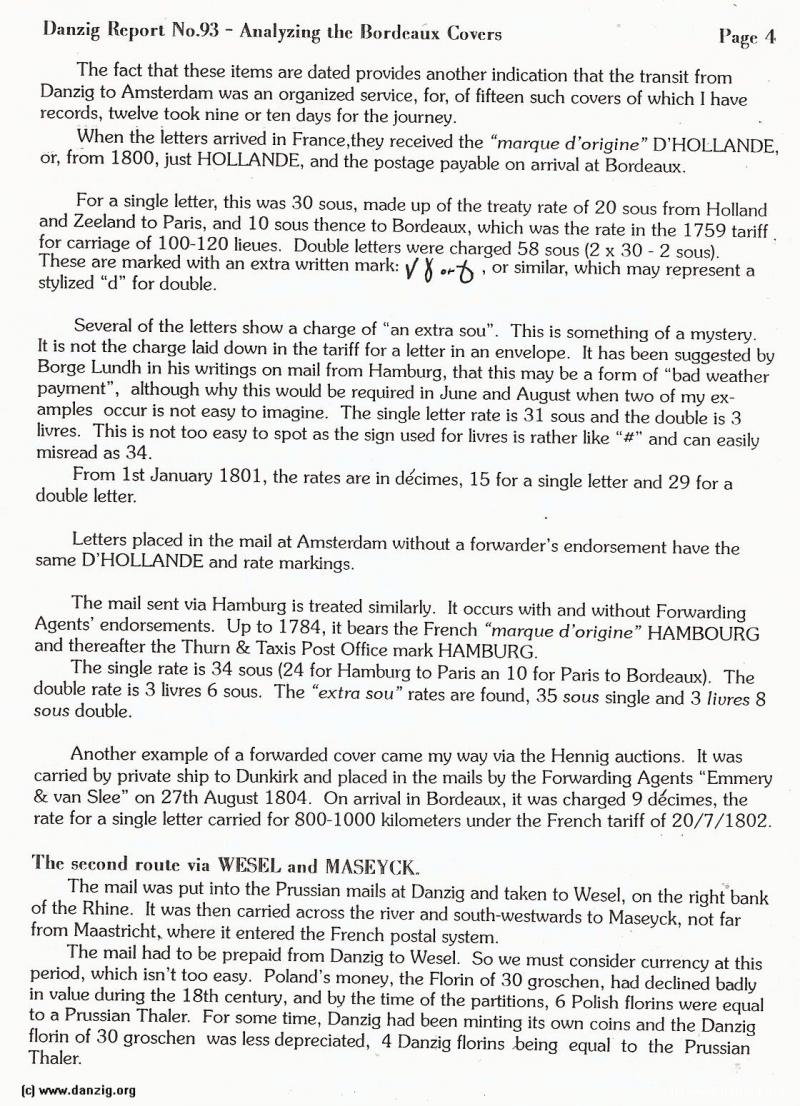
Thefact that these items are dated provides another indication that the transit from Danzig to Amsterdam was an organized service, for, of fifteen such covers of which I have records, twelve took nine or ten days for the journey.
When the letters arrived in France,they received the “marque d’origine” D’HOLLANDE, or, from 1800, just HOLLANDE, and the postage payable on arrival at Bordeaux.
For a single letter, this was 30 sous, made up of the treaty rate of 20 sous from Holland and Zeeland to Paris, and 10 sous thence to Bordeaux, which was the rate in the 1759 tariff for carriage of 100-120 lieues. Double letters were charged 58 sous (2 x 30 - 2 sotis). These are marked with an extra written mark:…., or similar, which may represent a stylized “d” for double.
Several of the letters show a charge of “an extra sou”. This is something of a mystery. It is not the charge laid down in the tariff for a letter in an envelope. It has been suggested by Borge Lundh in his writings on mail from Hamburg, that this may be a form of “bad weather payment”, although why this would be required in June and August when two of my exa mples occur is not easy to imagine. The single letter rate is 31 sous and the double is 3 hivres. This is not too easy to spot as the sign used for hivres is rather like “#“ and can easily misread as 34.
From 1st January 1801, the rates are in ddcimes, 15 for a single letter and 29 for a double letter.
Letters placed in the mail at Amsterdam without a forwarder’s endorsement have the same D’HOLLANDE and rate markings.
The mail sent via Hamburg is treated similarly. It occurs with and without Forwarding Agents’ endorsements. Up to 1784, it bears the French “marque d’origine” HAMBOURG and thereafter the Thurn & Taxis Post Office mark HAMBURG.
The single rate is 34 sous (24 for Hamburg to Paris an 10 for Paris to Bordeaux). The double rate is 3 livres 6 sous. The “extra sou” rates are found, 35 sous single and 3 liures 8 sous double.
Another example of a forwarded cover came my way via the Hennig auctions. It was carried by private ship to Dunkirk and placed in the mails by the Forwarding Agents “Emmery & van Slee” on 27th August 1804. On arrival in Bordeaux, it was charged 9 decimes, the rate for a single letter carried for 800-1000 kilometers under the French tariff of 20/7/1802.
The second route via WESKI., and MASKYCK.
The mail was put into the Prussian mails at Danzig and taken to Wesel, on the right bank of the Rhine. It was then carried across the river and south-westwards to Maseyck, not far from Maastricht,. where it entered the French postal system.
The mail had to be prepaid from Danzig to Wesel. So we must consider currency at this period, which isn’t too easy. Poland’s money, the Florin of 30 groschen, had declined badly in value during the 18th century, and by the time of the partitions, 6 Polish florins were equal to a Prussian Thaler. For some time, Danzig had been minting its own coins and the Danzig florin of 30 groschen was less depreciated, 4 Danzig florins being equal to the Prussian Thaler.
Danzig Report Vol. 1 - Nr. 93 - October - November - December - 1996, Page 4.
Hits: 3683
Added: 19/07/2015
Copyright: 2025 Danzig.org

